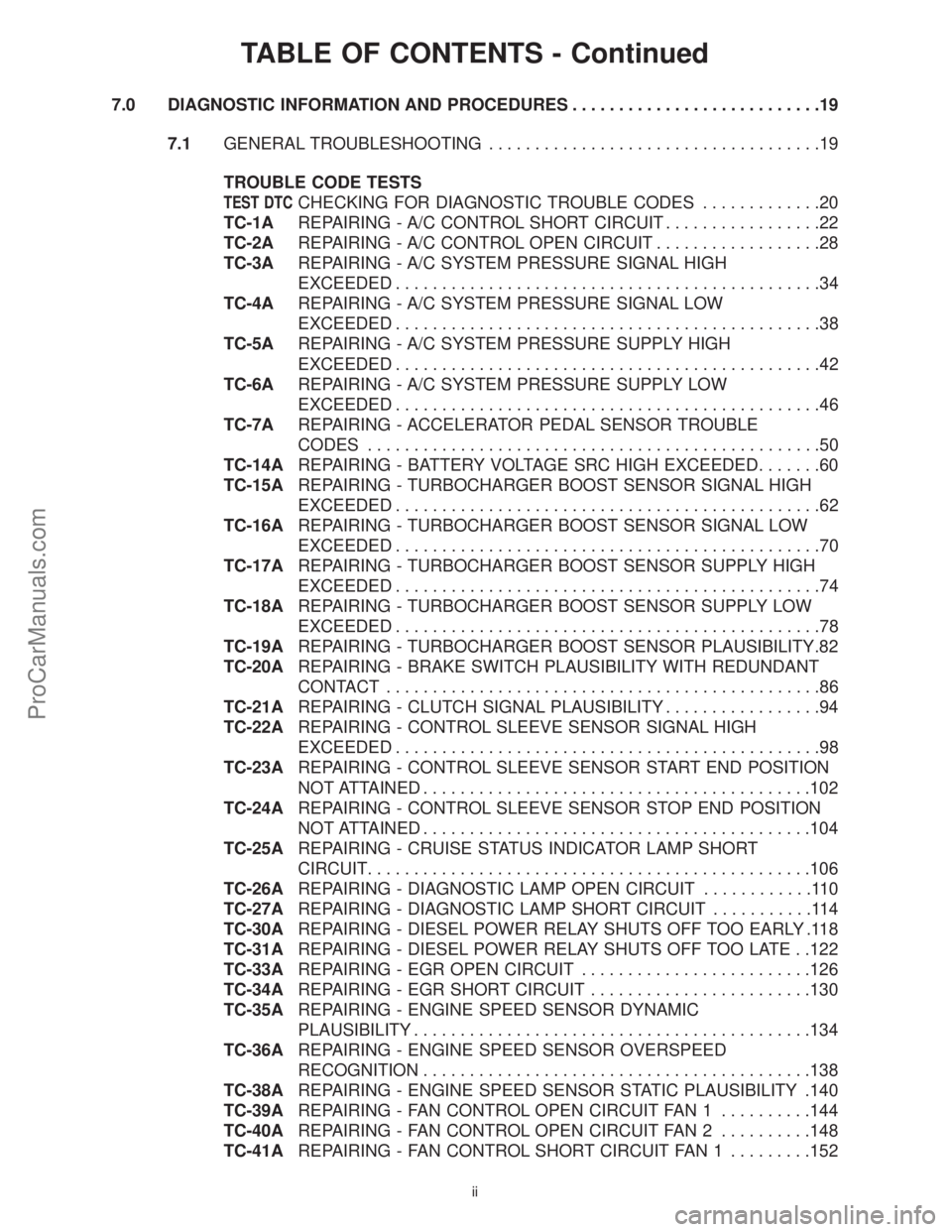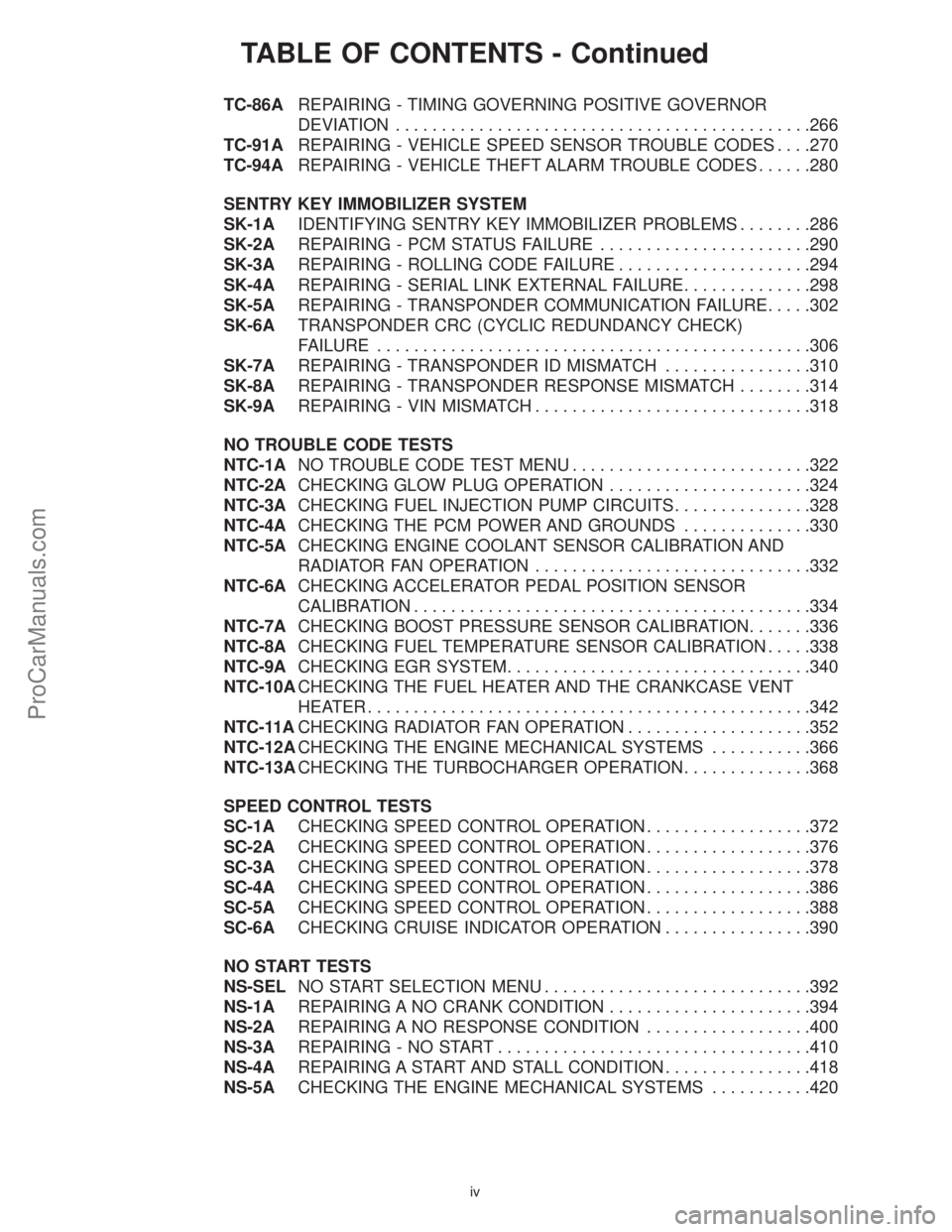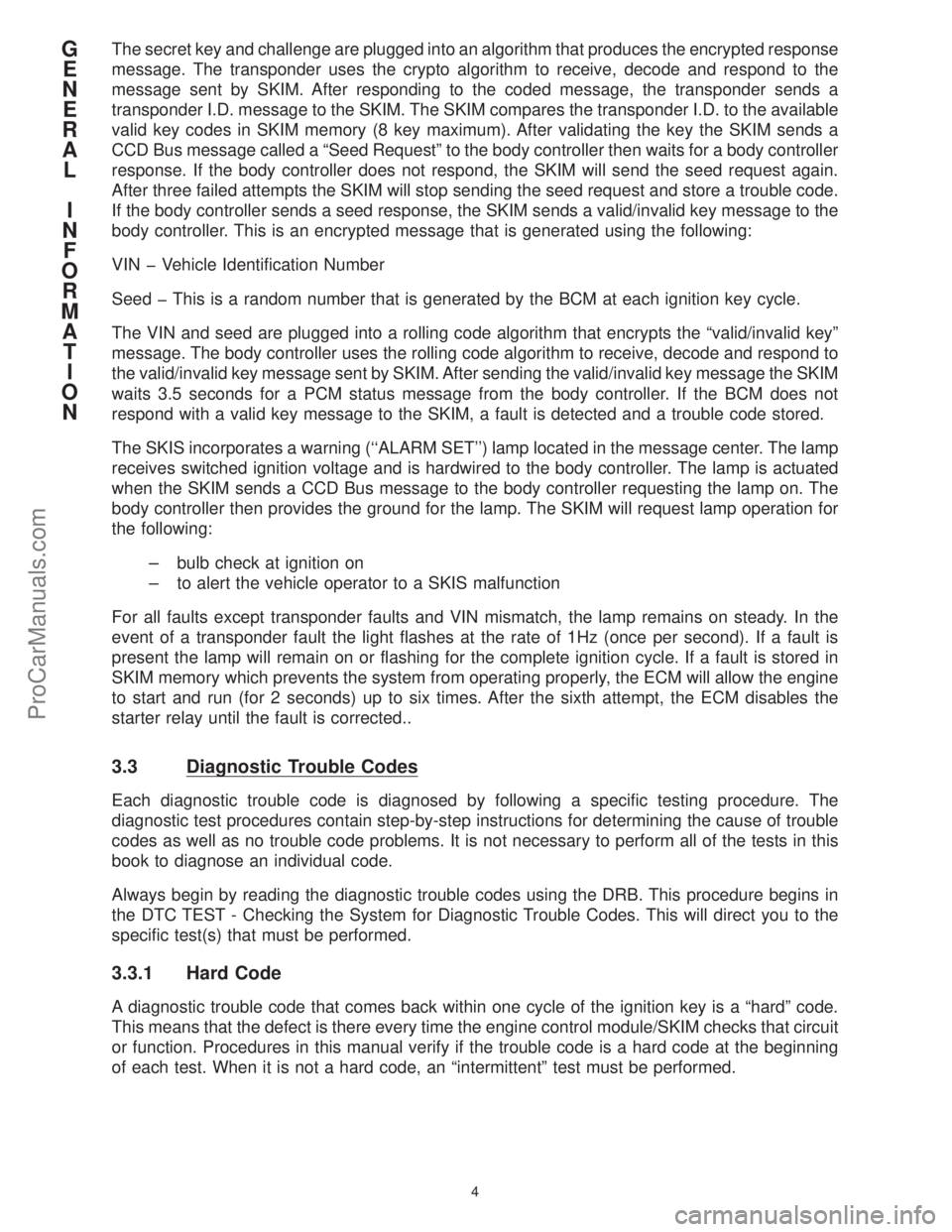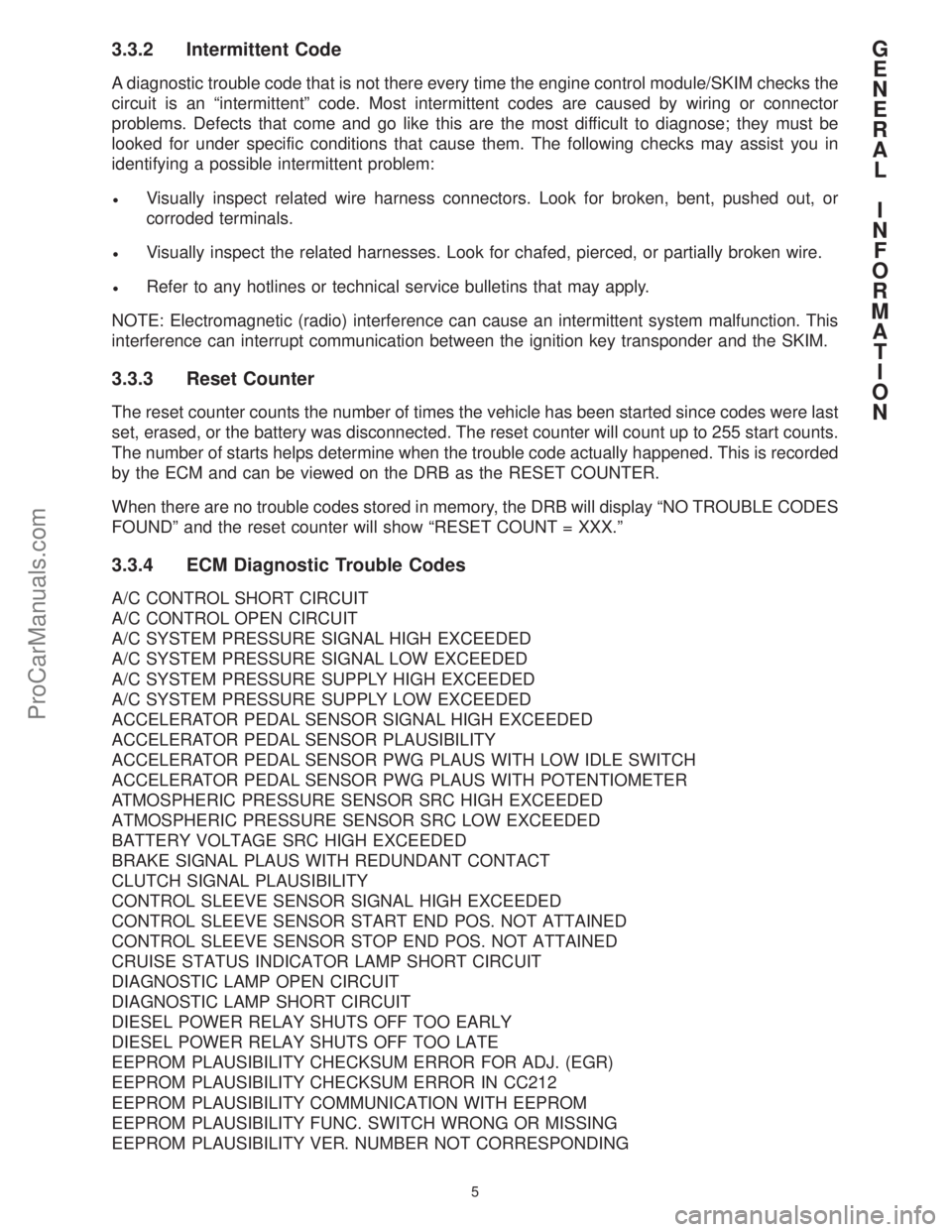check engine CHRYSLER CARAVAN 2000 Service Manual
[x] Cancel search | Manufacturer: CHRYSLER, Model Year: 2000, Model line: CARAVAN, Model: CHRYSLER CARAVAN 2000Pages: 436, PDF Size: 3.4 MB
Page 2 of 436

TABLE OF CONTENTS - Continued
7.0 DIAGNOSTIC INFORMATION AND PROCEDURES...........................19
7.1GENERAL TROUBLESHOOTING....................................19
TROUBLE CODE TESTS
TEST DTCCHECKING FOR DIAGNOSTIC TROUBLE CODES.............20
TC-1AREPAIRING - A/C CONTROL SHORT CIRCUIT.................22
TC-2AREPAIRING - A/C CONTROL OPEN CIRCUIT..................28
TC-3AREPAIRING - A/C SYSTEM PRESSURE SIGNAL HIGH
EXCEEDED..............................................34
TC-4AREPAIRING - A/C SYSTEM PRESSURE SIGNAL LOW
EXCEEDED..............................................38
TC-5AREPAIRING - A/C SYSTEM PRESSURE SUPPLY HIGH
EXCEEDED..............................................42
TC-6AREPAIRING - A/C SYSTEM PRESSURE SUPPLY LOW
EXCEEDED..............................................46
TC-7AREPAIRING - ACCELERATOR PEDAL SENSOR TROUBLE
CODES.................................................50
TC-14AREPAIRING - BATTERY VOLTAGE SRC HIGH EXCEEDED.......60
TC-15AREPAIRING - TURBOCHARGER BOOST SENSOR SIGNAL HIGH
EXCEEDED..............................................62
TC-16AREPAIRING - TURBOCHARGER BOOST SENSOR SIGNAL LOW
EXCEEDED..............................................70
TC-17AREPAIRING - TURBOCHARGER BOOST SENSOR SUPPLY HIGH
EXCEEDED..............................................74
TC-18AREPAIRING - TURBOCHARGER BOOST SENSOR SUPPLY LOW
EXCEEDED..............................................78
TC-19AREPAIRING - TURBOCHARGER BOOST SENSOR PLAUSIBILITY.82
TC-20AREPAIRING - BRAKE SWITCH PLAUSIBILITY WITH REDUNDANT
CONTACT...............................................86
TC-21AREPAIRING - CLUTCH SIGNAL PLAUSIBILITY.................94
TC-22AREPAIRING - CONTROL SLEEVE SENSOR SIGNAL HIGH
EXCEEDED..............................................98
TC-23AREPAIRING - CONTROL SLEEVE SENSOR START END POSITION
NOT ATTAINED..........................................102
TC-24AREPAIRING - CONTROL SLEEVE SENSOR STOP END POSITION
NOT ATTAINED..........................................104
TC-25AREPAIRING - CRUISE STATUS INDICATOR LAMP SHORT
CIRCUIT................................................106
TC-26AREPAIRING - DIAGNOSTIC LAMP OPEN CIRCUIT............110
TC-27AREPAIRING - DIAGNOSTIC LAMP SHORT CIRCUIT...........114
TC-30AREPAIRING - DIESEL POWER RELAY SHUTS OFF TOO EARLY .118
TC-31AREPAIRING - DIESEL POWER RELAY SHUTS OFF TOO LATE . .122
TC-33AREPAIRING - EGR OPEN CIRCUIT.........................126
TC-34AREPAIRING - EGR SHORT CIRCUIT........................130
TC-35AREPAIRING - ENGINE SPEED SENSOR DYNAMIC
PLAUSIBILITY...........................................134
TC-36AREPAIRING - ENGINE SPEED SENSOR OVERSPEED
RECOGNITION..........................................138
TC-38AREPAIRING - ENGINE SPEED SENSOR STATIC PLAUSIBILITY .140
TC-39AREPAIRING - FAN CONTROL OPEN CIRCUIT FAN 1..........144
TC-40AREPAIRING - FAN CONTROL OPEN CIRCUIT FAN 2..........148
TC-41AREPAIRING - FAN CONTROL SHORT CIRCUIT FAN 1.........152
ii
ProCarManuals.com
Page 4 of 436

TABLE OF CONTENTS - Continued
TC-86AREPAIRING - TIMING GOVERNING POSITIVE GOVERNOR
DEVIATION.............................................266
TC-91AREPAIRING - VEHICLE SPEED SENSOR TROUBLE CODES. . . .270
TC-94AREPAIRING - VEHICLE THEFT ALARM TROUBLE CODES......280
SENTRY KEY IMMOBILIZER SYSTEM
SK-1AIDENTIFYING SENTRY KEY IMMOBILIZER PROBLEMS........286
SK-2AREPAIRING - PCM STATUS FAILURE.......................290
SK-3AREPAIRING - ROLLING CODE FAILURE.....................294
SK-4AREPAIRING - SERIAL LINK EXTERNAL FAILURE..............298
SK-5AREPAIRING - TRANSPONDER COMMUNICATION FAILURE.....302
SK-6ATRANSPONDER CRC (CYCLIC REDUNDANCY CHECK)
FAILURE...............................................306
SK-7AREPAIRING - TRANSPONDER ID MISMATCH................310
SK-8AREPAIRING - TRANSPONDER RESPONSE MISMATCH........314
SK-9AREPAIRING - VIN MISMATCH..............................318
NO TROUBLE CODE TESTS
NTC-1ANO TROUBLE CODE TEST MENU..........................322
NTC-2ACHECKING GLOW PLUG OPERATION......................324
NTC-3ACHECKING FUEL INJECTION PUMP CIRCUITS...............328
NTC-4ACHECKING THE PCM POWER AND GROUNDS..............330
NTC-5ACHECKING ENGINE COOLANT SENSOR CALIBRATION AND
RADIATOR FAN OPERATION..............................332
NTC-6ACHECKING ACCELERATOR PEDAL POSITION SENSOR
CALIBRATION...........................................334
NTC-7ACHECKING BOOST PRESSURE SENSOR CALIBRATION.......336
NTC-8ACHECKING FUEL TEMPERATURE SENSOR CALIBRATION.....338
NTC-9ACHECKING EGR SYSTEM.................................340
NTC-10ACHECKING THE FUEL HEATER AND THE CRANKCASE VENT
HEATER................................................342
NTC-11ACHECKING RADIATOR FAN OPERATION....................352
NTC-12ACHECKING THE ENGINE MECHANICAL SYSTEMS...........366
NTC-13ACHECKING THE TURBOCHARGER OPERATION..............368
SPEED CONTROL TESTS
SC-1ACHECKING SPEED CONTROL OPERATION..................372
SC-2ACHECKING SPEED CONTROL OPERATION..................376
SC-3ACHECKING SPEED CONTROL OPERATION..................378
SC-4ACHECKING SPEED CONTROL OPERATION..................386
SC-5ACHECKING SPEED CONTROL OPERATION..................388
SC-6ACHECKING CRUISE INDICATOR OPERATION................390
NO START TESTS
NS-SELNO START SELECTION MENU.............................392
NS-1AREPAIRING A NO CRANK CONDITION......................394
NS-2AREPAIRING A NO RESPONSE CONDITION..................400
NS-3AREPAIRING - NO START..................................410
NS-4AREPAIRING A START AND STALL CONDITION................418
NS-5ACHECKING THE ENGINE MECHANICAL SYSTEMS...........420
iv
ProCarManuals.com
Page 9 of 436

After-Run- When fused ignition switch output is removed from the ECM cavity 47, the ECM
performs a self-diagnostic check in the following order:
1. Electrical shut-off test
2. Fuel quantity actuator test
3. Monitoring module test
4. Voltage regulator test
5. Main relay test (if tests 1-4 pass)
If any of tests 1-4 fail, the fault is stored in memory, and can be retrieved during the next ignition
cycle using the DRB.
3.2.3 Monitored Circuits
The ECM is able to monitor and identify most driveability related trouble conditions. Some circuits
are directly monitored through ECM feedback circuitry. In addition, the ECM monitors the voltage
state of some circuits and compares those states with expected values. Other systems are
monitored indirectly when the ECM conducts a rationality test to identify problems.
Although most subsystems of the powertrain control module are either directly or indirectly
monitored, there may be occasions when diagnostic trouble codes are not immediately identified.
For a trouble code to set, specific conditions must be met and unless these conditions are
encountered, a code will not set.
3.2.4 SKIS On-Board Diagnostics
The SKIS module has been programmed to transmit and monitor many different coded messages
as well as CCD Bus messages. This monitoring is called ``On-Board Diagnosis''.
Certain criteria must be met for a diagnostic trouble code to be entered into the Sentry Key
Immobilizer Module (SKIM) memory. The criteria may be a range of: input voltage, CCD Bus
messages, or coded messages to the SKIM. If all of the criteria for monitoring a circuit or function
are met and a fault is sensed, a diagnostic trouble code will be stored in the SKIM memory.
3.2.5 SKIS Overview
The Sentry Key Immobilizer System (SKIS) is an immobilizer system designed to prevent
unauthorized vehicle operation. The system consists of a Sentry Key Immobilizer Module (SKIM),
ignition key(s) equipped with a transponder chip, engine controller and body controller. When the
ignition switch is turned on, the SKIM interrogates the ignition key. If the ignition key is ªValidº the
SKIM sends a CCD Bus message to the body controller indicating the presence of a valid ignition
key. The BCM then supplies the ECM with a valid immobilizer signal allowing the engine to
continue to operate.
3.2.6 SKIS Operation
When ignition power is supplied to the SKIM, the SKIM performs an internal self-test. After the
self-test is completed, the SKIM energizes the antenna (this activates the transponder chip) and
sends a challenge to the transponder chip. The transponder chip responds to the challenge by
generating an encrypted response message using the following:
Secret Key þ This is an electronically stored value (identification number) that is unique to each
SKIS. The secret key is stored in the SKIM, BCM and all ignition key transponders.
Challenge þ This is a random number that is generated by the SKIM at each ignition key cycle.
G
E
N
E
R
A
L
I
N
F
O
R
M
A
T
I
O
N
3
ProCarManuals.com
Page 10 of 436

The secret key and challenge are plugged into an algorithm that produces the encrypted response
message. The transponder uses the crypto algorithm to receive, decode and respond to the
message sent by SKIM. After responding to the coded message, the transponder sends a
transponder I.D. message to the SKIM. The SKIM compares the transponder I.D. to the available
valid key codes in SKIM memory (8 key maximum). After validating the key the SKIM sends a
CCD Bus message called a ªSeed Requestº to the body controller then waits for a body controller
response. If the body controller does not respond, the SKIM will send the seed request again.
After three failed attempts the SKIM will stop sending the seed request and store a trouble code.
If the body controller sends a seed response, the SKIM sends a valid/invalid key message to the
body controller. This is an encrypted message that is generated using the following:
VIN þ Vehicle Identification Number
Seed þ This is a random number that is generated by the BCM at each ignition key cycle.
The VIN and seed are plugged into a rolling code algorithm that encrypts the ªvalid/invalid keyº
message. The body controller uses the rolling code algorithm to receive, decode and respond to
the valid/invalid key message sent by SKIM. After sending the valid/invalid key message the SKIM
waits 3.5 seconds for a PCM status message from the body controller. If the BCM does not
respond with a valid key message to the SKIM, a fault is detected and a trouble code stored.
The SKIS incorporates a warning (``ALARM SET'') lamp located in the message center. The lamp
receives switched ignition voltage and is hardwired to the body controller. The lamp is actuated
when the SKIM sends a CCD Bus message to the body controller requesting the lamp on. The
body controller then provides the ground for the lamp. The SKIM will request lamp operation for
the following:
± ± bulb check at ignition on
± to alert the vehicle operator to a SKIS malfunction
For all faults except transponder faults and VIN mismatch, the lamp remains on steady. In the
event of a transponder fault the light flashes at the rate of 1Hz (once per second). If a fault is
present the lamp will remain on or flashing for the complete ignition cycle. If a fault is stored in
SKIM memory which prevents the system from operating properly, the ECM will allow the engine
to start and run (for 2 seconds) up to six times. After the sixth attempt, the ECM disables the
starter relay until the fault is corrected..
3.3 Diagnostic Trouble Codes
Each diagnostic trouble code is diagnosed by following a specific testing procedure. The
diagnostic test procedures contain step-by-step instructions for determining the cause of trouble
codes as well as no trouble code problems. It is not necessary to perform all of the tests in this
book to diagnose an individual code.
Always begin by reading the diagnostic trouble codes using the DRB. This procedure begins in
the DTC TEST - Checking the System for Diagnostic Trouble Codes. This will direct you to the
specific test(s) that must be performed.
3.3.1 Hard Code
A diagnostic trouble code that comes back within one cycle of the ignition key is a ªhardº code.
This means that the defect is there every time the engine control module/SKIM checks that circuit
or function. Procedures in this manual verify if the trouble code is a hard code at the beginning
of each test. When it is not a hard code, an ªintermittentº test must be performed.
G
E
N
E
R
A
L
I
N
F
O
R
M
A
T
I
O
N
4
ProCarManuals.com
Page 11 of 436

3.3.2 Intermittent Code
A diagnostic trouble code that is not there every time the engine control module/SKIM checks the
circuit is an ªintermittentº code. Most intermittent codes are caused by wiring or connector
problems. Defects that come and go like this are the most difficult to diagnose; they must be
looked for under specific conditions that cause them. The following checks may assist you in
identifying a possible intermittent problem:
²Visually inspect related wire harness connectors. Look for broken, bent, pushed out, or
corroded terminals.
²Visually inspect the related harnesses. Look for chafed, pierced, or partially broken wire.
²Refer to any hotlines or technical service bulletins that may apply.
NOTE: Electromagnetic (radio) interference can cause an intermittent system malfunction. This
interference can interrupt communication between the ignition key transponder and the SKIM.
3.3.3 Reset Counter
The reset counter counts the number of times the vehicle has been started since codes were last
set, erased, or the battery was disconnected. The reset counter will count up to 255 start counts.
The number of starts helps determine when the trouble code actually happened. This is recorded
by the ECM and can be viewed on the DRB as the RESET COUNTER.
When there are no trouble codes stored in memory, the DRB will display ªNO TROUBLE CODES
FOUNDº and the reset counter will show ªRESET COUNT = XXX.º
3.3.4 ECM Diagnostic Trouble Codes
A/C CONTROL SHORT CIRCUIT
A/C CONTROL OPEN CIRCUIT
A/C SYSTEM PRESSURE SIGNAL HIGH EXCEEDED
A/C SYSTEM PRESSURE SIGNAL LOW EXCEEDED
A/C SYSTEM PRESSURE SUPPLY HIGH EXCEEDED
A/C SYSTEM PRESSURE SUPPLY LOW EXCEEDED
ACCELERATOR PEDAL SENSOR SIGNAL HIGH EXCEEDED
ACCELERATOR PEDAL SENSOR PLAUSIBILITY
ACCELERATOR PEDAL SENSOR PWG PLAUS WITH LOW IDLE SWITCH
ACCELERATOR PEDAL SENSOR PWG PLAUS WITH POTENTIOMETER
ATMOSPHERIC PRESSURE SENSOR SRC HIGH EXCEEDED
ATMOSPHERIC PRESSURE SENSOR SRC LOW EXCEEDED
BATTERY VOLTAGE SRC HIGH EXCEEDED
BRAKE SIGNAL PLAUS WITH REDUNDANT CONTACT
CLUTCH SIGNAL PLAUSIBILITY
CONTROL SLEEVE SENSOR SIGNAL HIGH EXCEEDED
CONTROL SLEEVE SENSOR START END POS. NOT ATTAINED
CONTROL SLEEVE SENSOR STOP END POS. NOT ATTAINED
CRUISE STATUS INDICATOR LAMP SHORT CIRCUIT
DIAGNOSTIC LAMP OPEN CIRCUIT
DIAGNOSTIC LAMP SHORT CIRCUIT
DIESEL POWER RELAY SHUTS OFF TOO EARLY
DIESEL POWER RELAY SHUTS OFF TOO LATE
EEPROM PLAUSIBILITY CHECKSUM ERROR FOR ADJ. (EGR)
EEPROM PLAUSIBILITY CHECKSUM ERROR IN CC212
EEPROM PLAUSIBILITY COMMUNICATION WITH EEPROM
EEPROM PLAUSIBILITY FUNC. SWITCH WRONG OR MISSING
EEPROM PLAUSIBILITY VER. NUMBER NOT CORRESPONDING
G
E
N
E
R
A
L
I
N
F
O
R
M
A
T
I
O
N
5
ProCarManuals.com
Page 26 of 436

TEST DTCCHECKING FOR DIAGNOSTIC TROUBLE CODES
NOTE: The battery must be fully charged for any test in this manual.
1. Attempt to start the engine. Crank for up to 10 seconds if necessary.
2. Connect the DRB to the data link connector. Write down the trouble codes that are displayed.
3. If the DRB displays ``No Response'', go toTEST NS-2A.
4. If the DRB screen is blank or has a DRB error message, go toGeneral Information Section
3.5in this manual.
5. Iftrouble code messagesare displayed, refer to the trouble code list below and on the
following page for the appropriate test.
6. If there are no ECM trouble codes displayed, refer to one of the following:
For Immobilizer problems..................................................SK-1A
For Driveability problems.................................................NTC-1A
For No Start problems....................................................NS-1A
For Speed Control problems...............................................SC-1A
NOTE:For all component locations see General Information Section 4.0 in this manual.
DRB DIAGNOSTIC TROUBLE CODE (DTC) DISPLAYEDDIAGNOSTIC
TESTSCAN
TOOL
AC Control Short CircuitTC-1 P1655
A/C Control Open CircuitTC-2 P1655
A/C System Pressure Signal High Exceeded TC-3 P1695
A/C System Pressure Signal Low Exceeded TC-4 P1695
A/C System Pressure Supply High Exceeded TC-5 P1695
A/C System Pressure Supply Low Exceeded TC-6 P1695
Accelerator Pedal Sensor High Exceeded TC-7 P1515
Accelerator Pedal Sensor PlausibilityTC-7 P1515
Accelerator Pedal Sensor Pwg Plaus With Low Idle Switch TC-7 P1515
Accelerator Pedal Sensor Pwg Plaus With Potentiometer TC-7 P1515
Atmospheric Pressure Sensor SRC High Exceeded ** P1105
Atmospheric Pressure Sensor SRC Low Exceeded ** P1105
Battery Voltage SRC High Exceeded TC-14 P1600
Turbocharger Boost Sensor Signal High Exceeded TC-15 P0235
Turbocharger Boost Sensor Signal Low Exceeded TC-16 P0235
Turbocharger Boost Sensor Supply High Exceeded TC-17 P0235
Turbocharger Boost Sensor Supply Low Exceeded TC-18 P0235
Turbocharger Boost Sensor Plausibility TC-19 P0235
Brake Signal Plaus With Redundant Contact TC-20 P1703
Clutch Signal PlausibilityTC-21 P1740
Control Sleeve Sensor Signal High Exceeded TC-22 P1225
Control Sleeve Sensor Start End Pos. Not Attained TC-23 P1225
Control Sleeve Sensor Stop End Pos. Not Attained TC-24 P1225
Cruise Status Indicator Lamp Short Circuit TC-25 P1665
Diagnostic Lamp Open CircuitTC-26 P1650
Diagnostic Lamp Short CircuitTC-27 P1650
Diesel Power Relay Shuts Off Too Early TC-30 P1625
Diesel Power Relay Shuts Off Too Late TC-31 P1625
EEPROM Plausibility Checksum Error For Adj. ** P1680
EEPROM Plausibility Checksum Error in CC212 ** P1680
EEPROM Plausibility Communication with EEPROM ** P1680
EEPROM Plausibility Func. Switch Wrong or Missing ** P1680
EEPROM Plausibility Ver. Number Not Corresponding ** P1680
EGR Open CircuitTC-33 P0400
EGR Short CircuitTC-34 P0400
Engine Speed Sensor Dynamic Plausibility TC-35 P0725
T
R
O
U
B
L
E
C
O
D
E
T
E
S
T
S
20
ProCarManuals.com
Page 27 of 436

TEST DTCCHECKING FOR DIAGNOSTIC TROUBLE CODES
DRBIIITDIAGNOSTIC TROUBLE CODE (DTC) DISPLAYEDDIAGNOSTIC
TESTSCAN
TOOL
Engine Speed Sensor Over Speed Recognition TC-36 P0725
Engine Speed Sensor Static Plausibility TC-38 P0725
Fan Control Open Circuit Fan #1TC-39 P1690
Fan Control Open Circuit Fan #2TC-40 P1690
Fan Control Short Circuit Fan #1TC-41 P1690
Fan Control Short Circuit Fan #2TC-42 P1690
Fuel Quantity Actuator Neg. Gov. Deviation Cold TC-43 P1220
Fuel Quantity Actuator Neg. Gov. Deviation Warm TC-44 P1220
Fuel Quantity Actuator Pos. Gov. Deviation Cold TC-45 P1220
Fuel Quantity Actuator Pos. Gov. Deviation Warm TC-46 P1220
Fuel Temperature Sensor SRC High Exceeded TC-47 P0180
Fuel Temperature Sensor SRC Low Exceeded TC-48 P0180
Glow Relay #1 Controller Open Circuit TC-51 P1635
Glow Relay #2 Controller Open Circuit TC-52 P1635
Glow Relay #1 Controller Short Circuit TC-53 P1635
Glow Relay #2 Controller Short Circuit TC-54 P1635
Inductive Aux. Speed Sensor Dynamic Plausibility TC-56 P1725
Inductive Aux. Speed Sensor Overspeed Recognition TC-57 P1725
Inductive Aux. Speed Sensor Plausibility TC-58 P1725
Inductive Aux. Speed Sensor Static Plausibility TC-59 P1725
Intake Air Temperature Sensor Signal High Exceeded TC-62 P0110
Intake Air Temperature Sensor Signal Low Exceeded TC-63 P0110
Microcontroller Gate-array Monitoring** P1615
Microcontroller Gate-array Watchdog** P1615
Microcontroller Prepare Fuel Quantity Stop ** P1615
Microcontroller Recovery Has Occurred ** P1615
Microcontroller Redundant Overrun Monitoring ** P1615
Needle Movement Sensor High Exceeded TC-72 P1201
Needle Movement Sensor Low Exceeded TC-73 P1201
Redundant Emer. Stop Plausibility in After-run TC-74 P1660
Redundant Emer. Stop Powerstate Defective TC-75 P1660
Regulator Lower Regulator Limit** P1610
Regulator Upper Regulator Limit** P1610
Smart Start Relay Short CircuitTC-76 P1675
Solenoid Valve Controller Open Circuit TC-79 P1630
Solenoid Valve Controller Short Circuit TC-80 P1630
Temperature of Engine Coolant SRC High Exceeded TC-81 P0115
Temperature of Engine Coolant SRC Low Exceeded TC-82 P0115
Terminal #15 Plausibility After Start-up TC-84 P1605
Timing Governing Negative Governor Deviation TC-85 P1230
Timing Governing Positive Governor Deviation TC-86 P1230
UþREF (2.5V)** P1620
Vehicle Speed Sensor Pec Frequency Too High TC-91 P0500
Vehicle Speed Sensor Signal High Exceeded TC-91 P0500
Vehicle Speed Sensor PlausibilityTC-91 P0500
Immobilizer Signal LostTC-94 P1685
Invalid SKIM MessageTC-94 P1685
** These trouble codes indicate an internal ECM fault. Using the DRB, clear ECM trouble code(s).
Perform several engine run cycles turning the ignition off for at least 10 seconds between cycles.
Using the DRB, read ECM trouble codes. If the code is present, replace the Engine Control Module.
NOTE: If trouble code TERMINAL 15 PLAUSIBILITY AFTER START-UP is present with other trouble
codes, perform TC-84 diagnosis first.
T
R
O
U
B
L
E
C
O
D
E
T
E
S
T
S
21
ProCarManuals.com
Page 31 of 436

TEST TC-1ACONTINUED - REPAIRING - A/C CONTROL SHORT CIRCUIT
*Perform Verification TEST VER-2A. **Check connectors - Clean / repair as necessary.
TEST TC-1A TURN IGNITION ON.
CONTINUED FROM IS THE A/C CLUTCH NO CONTINUE TEST
THE PREVIOUS WITH THE DRB, RELAY CLICKING? TC-1A ON THE
PAGE. ACTUATE THE A/C NEXT PAGE.
CLUTCH RELAY.
YES
THE CONDITION TO SET USING THE SCHEMATIC
THE TROUBLE CODE IS AS A GUIDE, INSPECT WERE ANY PROBLEMS YES REPAIR AS
NOT PRESENT. THE WIRING AND FOUND? NECESSARY.*
CONNECTORS.
FIG.1 FIG.2
NO
WIGGLE THE WIRING NOTE: THE DRB MUST REPAIR AS
HARNESS FROM THE STILL BE ACTUATING DID THE WIGGLING YES NECESSARY WHERE
RELAY TO THE THE A/C CLUTCH INTERRUPT THE WIGGLING CAUSED
ENGINE CONTROL RELAY. CLICKING? CLICKING TO BE
MODULE.INTERRUPTED.*
NO
REFER TO GENERAL
INFORMATION 3.3.2 YES
FOR ADDITIONAL TEST COMPLETED.*
INFORMATION ON
INTERMITTENT CODES.
T
R
O
U
B
L
E
C
O
D
E
T
E
S
T
S
25
ProCarManuals.com
Page 33 of 436

TEST TC-1ACONTINUED - REPAIRING - A/C CONTROL SHORT CIRCUIT
*Perform Verification TEST VER-2A. **Check connectors - Clean / repair as necessary.
TEST TC-1A
CONTINUED FROM TURN IGNITION OFF.
THE PREVIOUS REMOVE THE A/C
PAGE. CLUTCH RELAY.**
USING AN OHMMETER, 85 AND 86 IS THE RESISTANCE
MEASURE RESISTANCE 85 AND 87 BELOW 30.0 OHMS YES REPLACE THE A/C
BETWEEN A/C CLUTCH 85 AND 30 FOR ANY OF THE CLUTCH RELAY.*
RELAY TERMINALS... 85 AND 87A MEASUREMENTS?
FIG.2
NO
DISCONNECT THE ECM REMOVE THE DIESEL
HARNESS POWER RELAY.**
CONNECTORS.**
WITH A JUMPER WIRE, TURN IGNITION ON.
CONNECT DIESEL POWER
RELAY CONN. CAVITIES USE A VOLTMETER IN
30 AND 87 (IN PDC). THE FOLLOWING
FIG.3 STEP.
MEASURE THE RELAYREPAIR A/C CLUTCH
CONTROL CIRCUIT AT IS THE VOLTAGE YES RELAY CONTROL
RELAY CONNECTOR ABOVE 1.0 VOLT? CIRCUIT FOR SHORT
(IN PDC).TO VOLTAGE.*
FIG.1
NO
REPLACE THE ENGINE
CONTROL MODULE.*
T
R
O
U
B
L
E
C
O
D
E
T
E
S
T
S
27
ProCarManuals.com
Page 37 of 436

TEST TC-2ACONTINUED - REPAIRING - A/C CONTROL OPEN CIRCUIT
*Perform Verification TEST VER-2A. **Check connectors - Clean / repair as necessary.
TEST TC-2A TURN IGNITION ON.
CONTINUED FROM IS THE A/C CLUTCH NO CONTINUE TEST
THE PREVIOUS WITH THE DRB, RELAY CLICKING? TC-2A ON THE
PAGE. ACTUATE THE A/C NEXT PAGE.
CLUTCH RELAY.
YES
THE CONDITION TO SET USING THE SCHEMATIC
THE TROUBLE CODE IS AS A GUIDE, INSPECT WERE ANY PROBLEMS YES REPAIR AS
NOT PRESENT. THE WIRING AND FOUND? NECESSARY.*
CONNECTORS.
FIG.1 FIG.2
NO
WIGGLE THE WIRING NOTE: THE DRB MUST REPAIR AS
HARNESS FROM THE STILL BE ACTUATING DID THE WIGGLING YES NECESSARY WHERE
RELAY TO THE THE A/C CLUTCH INTERRUPT THE WIGGLING CAUSED
ENGINE CONTROL RELAY. CLICKING? CLICKING TO BE
MODULE.INTERRUPTED.*
NO
REFER TO GENERAL
INFORMATION 3.3.2 YES
FOR ADDITIONAL TEST COMPLETED.*
INFORMATION ON
INTERMITTENT CODES.
T
R
O
U
B
L
E
C
O
D
E
T
E
S
T
S
31
ProCarManuals.com